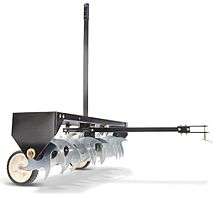Lawn aerator
A lawn aerator is a garden tool designed to create holes in the soil in order to help lawn grasses grow.[1] In compacted lawns, aeration improves soil drainage and encourages worms, microfauna and microflora which require oxygen.[2]
Lawn problems
Lawn aeration constitutes three things: controlling lawn thatch, and reducing soil compaction, making grass roots multiply. Aerating either by coring or spiking causes the roots to divide or sever apart, which rarely happens naturally. Severing the roots causes them to multiply and thus the blades of grass multiply keeping the lawn thick and deeply rooted as the holes become engorged with roots. Lawn thatch is a layer of dead organic tissue that can protect the lawn by moderating temperature and reducing evapotranspiration when it is a reasonable thickness, but too much thatch can limit soil oxygenation and reduce watering effectiveness. Soil compaction makes it difficult for grass to develop long roots and disturbs both natural rainwater and artificial irrigation.[3]
Types of aerators
There are two types of lawn aerators:
- spike aerators use wedge shaped solid spikes to punch holes in the soil
- core aerators have hollow tines that pull out plugs (or "cores") from soil

Core/plug aerator vs. spike aerator
A spike aerator creates holes in the ground by pushing the soil sideways as wedge-shaped spikes penetrate the soil. Since there is no soil removed from the ground, watering will cause the compacted soil around the holes to expand and close. A core/plug aerator removes soil from the ground and leaves the core on the turf. This reduces compaction in the soil, and the holes can stay open for a long time allowing air, fertilisers, and water to reach the roots. Core aeration is suitable for heavy clay soils, and spike aeration is more suited to sandy or loamy soils.
Powered aerator vs. manual aerator
Powered aerators employ the power from ground propulsion to drive multiple tines into ground. The machines can aerate a large lawn in a relatively short time (similar to mowing speed).
Manual aerators usually have two to five hollow tines mounted on a step bar. The operator puts one foot on the step bar and push it downward, forcing the tines to penetrate into the soil. Then he pulls the handle on the step bar upward to remove the soil cores out of the ground. By repeating the same operation, the cores left in the tines will be pushed out by the next ones. Manual aerators are much cheaper than powered ones. The trade-off is the speed. For a typical residential lawn (1/4 acre lot), it will take hours to finish. Some products also have issues with the tines becoming clogged with soil, which can slow down the operation even more. However, a well-made manual aerator offers advantages such as ease of use, selective aeration, and economy.
References
- "How to Use a Gas Aerator". SFGate. Hearst Communications, Inc. Retrieved 20 October 2017.
- Lauderdale, Danny; Roberson, Sarah. "Happy Gardening! You Have Earthworms!". NC Cooperative Extension. North Carolina State University. Retrieved 20 October 2017.
- Tukey, Paul (2007). The Organic Lawn Care Manual. Storey Publishing. pp. 97-98. ISBN 1580176496. Retrieved 20 October 2017.
External links
![]()
See also
- Grass stitcher